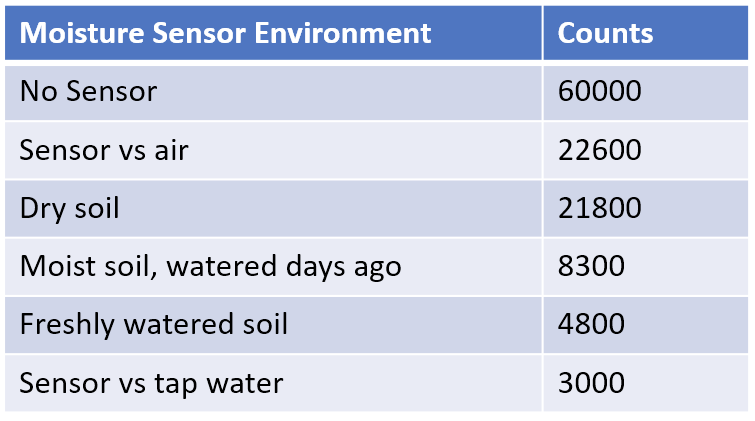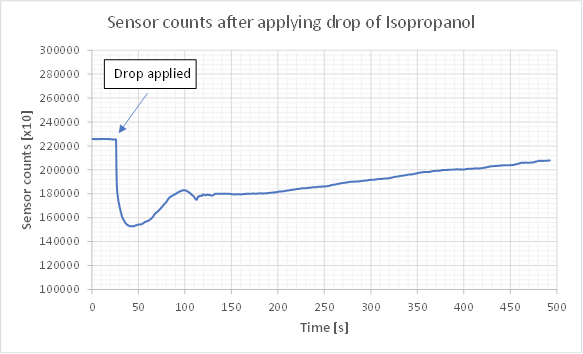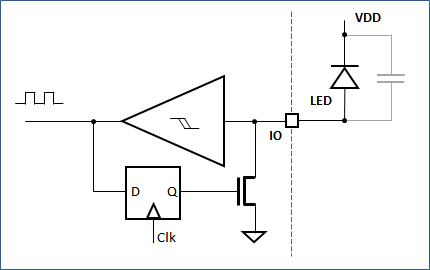Sensors Based on the Padauk RFC Peripheral
Exploring the undocumented Resistance to Frequency Converter (RFC) peripheral of the Padauk PFS173 Microcontroller
Exploring the undocumented Resistance to Frequency Converter (RFC) peripheral of the Padauk PFS173 Microcontroller
To make the experience fit your profile, pick a username and tell us what interests you.
We found and based on your interests.
One curious type of sensor that can be realized with simple means is a soil moisture sensor to monitor wether plants need to be watered. A simple way of achieving this is to measure the soil resistivity with two electrodes. Unfortunately that is not very reliable due to corrosion of the electrodes.
A much better approach is a capacitive sensor, for example as shown here. The sensing principle exploits the fact that water has a much higher (~80) relative dielectric constant than dry sol or air (~1). The sensing element consists of a planar capacitor that is directly inserted into the soil. This can be very easily realized by copper traces on a PCB that is insulated with solder resist. Coincidentally I found a sensing element that I designed years ago. The layout is shown here:
Below you can see how it is inserted into a potted plant.
Since this sensor is essentially a variable capacitor, it can be easily read out with the RFC peripheral. Since the capacitance of the sensor is relatively low, I chose a resistor of 47 kOhm to achieved a reasonably low frequency.
Of course, the resistor does also directly influence current consumption of the oscillator, hence choosing a larger resistor is sensible. 

In summary, the RFC seems to be well suited for this application. Time for a design project?
Using LEDs as light sensors is a hack tried by many. If operated under reverse bias conditions, LEDs act as photodiodes. Due to their small size, the generated photocurrent is extremely small, so some tricks have to be employed to measure it.
I tested the concept with a red 5mm LED. Counting time was 500 ms. With these settings it was clearly possible to discern different light level from total darkness to direct bright light as shown in the table above.
Since the GPIO can be reconfigured, it would be possible to use an LED in dual function as a light detector and indicator without having to add additional parts.
A quick estimation how much current we are measuring:
=> Iph = cnts * 50pF*3V/500ms = cnts * 300 pA
One count corresponds to only 300 pA of photocurrent!
Of course, there are numerous imperfections in this set up, including leakage currents and nonlinear C(V) behavior, so we cannot expect a highly linear light sensor from this. But it should be sufficient if only a threshold needs to be detected.
The documentation found earlier by JS provides a basic functional explanation and has a list of registers, but is a bit light on details. Nothing that can't be investigated...
The image above shows my interpretation of the "C-type" operation of the RFC. Basically it consists of a schmitt trigger and a ground switch. If an RC-couple (as shown) is connected between the IO-pin and the positive supply, the input voltage will slowly increase according to the RC time constant. If a certain trigger voltage is reached, the ground switch will short the input to ground until the lower trigger voltage is reached. Each time this happens, the counter increases by one. Effectively, this circuit forms a relaxation oscillator.
By evaluating the number of counts during a fixed interval, it is possible to measure changes in the capacitance or resistance.
The table above shows the register mapping. The control register allows selecting the specific pin. Bit 4 needs to be written to to start and stop the counter.
__sfr __at(0x2d) _rfcc;
__sfr __at(0x2e) _rfccrh;
__sfr __at(0x2f) _rfccrl;
#define RFCC _rfcc
#define RFCCRH _rfccrh
#define RFCCRL _rfccrl
Register mapping is shown above. Using the RFC is rather simple, as shown below:
RFCC = 0xc0 | 0x08 | 0x02 ; // Select PB6, set to C-Mode, enable output
uint16_t result;
RFCC|= 1<<4; // start RFC
_delay_ms(50);
RFCC&=~(1<<4); // stop RFC
result=(RFCCRH<<8)|RFCCRL;
The scope picture shows the voltage on the RFC pin during operation. In this case a 100nF capacitor and 10 kOhm resistor were connected in parallel to VDD.
It can be cleary seen that the charging of the RC element follows an exponential. The upper trigger voltage is 4V, the lower trigger voltage is ~700 mV. The origin of the ringing at the lower voltage is not clear to me, it seems to be an artifact of the RFC peripheral.
The impedance of the ground switch seems to be relatively high. In this case, with the 100nF capacitor, it takes about 11 µs to discharge.
When using a lower capacitor value, the counting frequency increases propertionally. The minimum discharge time seems to be 1 IHRC cycle (IHRC was 16 MHz in this device = 62.5 ns). In that case a voltage undershoot to 0V is observed. It is clear that operation of the RC oscillator will be instable when the reset voltage is not properly defined. It seems to be advised to adjust the capacitance value so that the reset time is either below one IHRC cycle (reset voltage will be 0V), or significantly above (reset voltage will be 700 mV).
An additional parameter of interest would be how the oscillator frequency changes with supply voltage.
I measured the frequency of an oscillator with R=10 kOhm and C=100nF for different values of VDD.
Great, looks like the RFC works exactly as (not) advertised. What can we use it for?
Padauk is a Taiwanese supplier of ultra-low cost microcontrollers, notorious for the "3 cent MCU". The supplier itself only offers a closed tool chain with a proprietary C-style language. In the mean time, an open sourced and independently created tool-chain, partially based on reverse engineering, became available.
There are still some areas that are not completely understood. One topic is the initial state of the I/O registers. The behavior of the real device is somewhat inconsistent to the datasheet, which may be due to an errata or due to different behavior of the proprietary and open toolchain.
To investigate this behavior in detail on the Padauk PFS173-S16, a small program was used to copy the entire I/O space to the RAM directly after startup. Since no indexed access of the I/O registers is possible, individual instructions had to be generated to copy each address.
After proper initialization of the MCU peripherals, the I/O area back up is dumped via the serial port.
Create an account to leave a comment. Already have an account? Log In.
Become a member to follow this project and never miss any updates